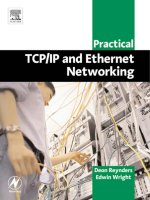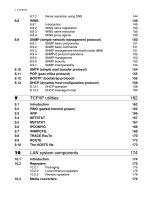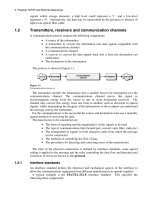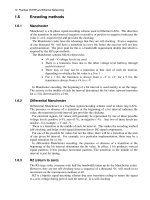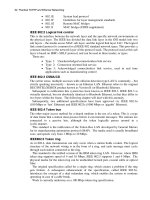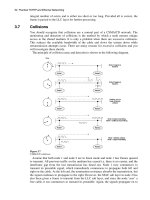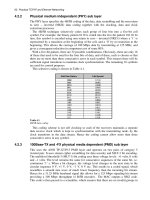Practical TCP/IP and Ethernet Networking- P33 doc
Bạn đang xem bản rút gọn của tài liệu. Xem và tải ngay bản đầy đủ của tài liệu tại đây (47.79 KB, 5 trang )
142 Practical TCP/IP and Ethernet Networking
2 Reconnection
3 Suppress go ahead – i.e. no longer send go-ahead signal after
data
4 Approximate message size negotiation
5 Status request – used to obtain the status of a TELNET
option from the remote machine.
6 Request timing mark – used to synchronize the two ends of a
connection
7 Remote controlled transmission and echo
8 Output line width
9 Output page length
10 Output carriage-return action
11 Output horizontal tab stop setting
12 Output horizontal tab stop action
13 Output form feed action
14 Output vertical tab stop setting
15 Output vertical tab stop action
16 Output line feed action
17 Extend ASCII characters
18 Logout
24 Terminal type – used to exchange information about the
make and model of a terminal being used
25 End of record – sent at end of data
28 Terminal location number
31 Window size
34 Line-mode – uses local editing and sends complete lines
instead of individual characters.
The two-octet sequence may be followed by a third octet containing optional
parameters.
An optional code of 1 indicates ‘ECHO’; therefore, the three octets sequence 255-251-1
means ‘WILL ECHO’ and instructs the other end to begin echoing back the characters
that it receives.
A command sequence of 255-252-1 indicates that the sender either will not echo back
characters or wants to stop echoing.
The negotiation of options allows clients and servers to optimize their interaction. It is
also possible for newer versions of TELNET software that provide more options to work
with older versions, as only the options that are recognized by both ends
are negotiated.
If the server application malfunctions and stops reading data from the TCP connection,
the operating system buffers will fill up until TCP eventually indicates to the client
system a window size of zero, thus preventing further data flow from the client. In such a
situation TELNET control codes will not be read and therefore will have no effect. To
bypass the normal flow control mechanism, TELNET uses an ‘out of band’ signal.
Whenever it places a control signal in the data stream, it also sends a SYNCH command
and appends a data mark octet. This induces TCP to send a segment with the URGENT
DATA flag set, which reaches the server directly and causes it to read and discard all data
until it finds the data mark in the data stream, after which it returns to normal processing.
TELNET programs are freely available and can be downloaded through the Internet.
Windows 95/98 includes a simple TELNET program called Microsoft TELNET 1.0.
Application layer protocols 143
Figure 8.5
TELNET login (courtesy of Microsoft Corporation)
8.5 RLOGIN (remote login)
The Rlogin service is related to TELNET but is typically used in a UNIX environment.
In the case of TELNET, a user at any type of TCP/IP host can log into any other type of
TCP/IP host. The local host and remote host may be running totally different operating
systems. Rlogin, on the other hand, is normally used when a user at a local UNIX host
wants to log into a remote UNIX host.
Rlogin is somewhat easier to use than TELNET and provides a few additional services.
For example, it allows the user to maintain a list of hosts in a rhosts file so the user does
not have to enter a user name and password at the time of each login.
8.6 NFS (network file system)
NFS was originally created by SUN Microsystems to share resources (files and
directories) among hosts running UNIX with a local host in such a way that all resources
seem to be resident on the local host. Because of its popularity implementations have
been created on other operating systems such as UNIX, OS/2, Microsoft Windows and
NetWare.
Say that a company stores all of the company sales reports on computer sales1. Users
from the marketing department wish to access those reports from their computer,
market1, without having to log in into sales1, or copy everything from one machine to
the other.
Both computers are connected together on the same TCP/IP network and both have
NFS installed and running. The reports are contained in the sales/reports directory on the
sales1 computer.
To share the sales reports, the administrator from sales1 types the following command:
share -F nfs/sales/reports
This command makes the sales/reports directory available to any other computer on the
network that can access sales1. The -F option identifies the resource being shared as an
NFS file system. Other options could be used to restrict access to certain computers and
to allow read/write or read-only access.
144 Practical TCP/IP and Ethernet Networking
On the computer named market1, the system administrator decides to connect the
reports directory to the directory called usr2/salesrpt locally using this command:
Mount -F nfs sales1:/sales/reports/usr2/salesrpt
Once the directory is mounted users can:
• Change to the /usr2/salesrpt directory, list the content, open the files and use
any standard commands to access and work with the local files
• Move down and search the subdirectories beneath the mount point on the
remote system
• Run applications stored on remote file system so that they run as any other
application on the local system
• Access the files and directories based on standard UNIX file system
permissions
8.7 DNS (domain name system)
8.7.1 Name resolution using hosts files
In small TCP/IP internetworks hosts are typically given simple names such as
computer1. The mapping between these host names and their associated IP addresses is
then maintained as a ‘flat’ database in a local file (the hosts file) on each host. The
resolver process on each host translates host names into IP addresses by a simple lookup
procedure.
In a large network the maintenance of the hosts files, which have to be identical for all
hosts and continuously updated in order to reflect additions and changes, can become
quite a tedious task. On the Internet, with millions of names, this becomes impossible.
8.7.2 Name resolution using DNS
The domain name system (DNS) provides a network-wide (and in the case of the
Internet – a world-wide) directory service that maps host names against IP addresses. For
most users this is a transparent process and not relevant whether the resolution takes place
via a hosts file or via DNS.
When the IP address of a specific destination host has to be resolved, the DNS resolver
on the source host contacts a DNS server somewhere on the internetwork. There is
usually more than one DNS server, and the database may be distributed among them.
Where an individual DNS server does not have access to the entire database, the host’s
name resolver may have to contact more than one DNS server, or the DNS servers may
exchange information amongst themselves in order to resolve the query.
Each DNS name server maintains a tree-structured directory database. The collective
database stored on all the DNS servers forms a global namespace of all the hosts that can
be referenced anywhere on the internetwork.
The Internet naming scheme hierarchical namespace
The original Internet namespace was ‘flat’ i.e. it had no hierarchical structure. At this
stage it was still administered by the Network Information Center (NIC). The task
eventually became too large because of the rapidly increasing number of hosts and a
hierarchical (tree-structured) namespace was adopted. At present, the ultimate
responsibility for the maintenance of this namespace is vested in the Internet Assigned
Names Authority (IANA).
Application layer protocols 145
In a domain name, the most local domain is written first and the most global domain is
written last. The domain name purdue.edu might identify Purdue University. This domain
name is registered against a specific IP address. The administrator of this domain name
may now create sub-domains such as, say, cs.purdue.edu for the computer science
department at Purdue University. The administrator of the computer science department,
in turn, may assign a fully qualified domain name (FQDN) to an individual host as
follows:
computer1.cs.purdue.edu
If a user is referring to a specific host within a local network, a FAQN is not needed, as
the DNS resolver will automatically supply the missing high-level domain name qualifier.
The following commands are therefore equivalent when the ftp client and ftp server are
located on the same network:
• ftp computer1.purdue.edu
• ftp computer1
Standard domain names
The original namespace contained a set of standard top-level domains without any
reference to a specific country. Since the original Internet was not envisaged to exist
beyond the borders of the United States, the absence of any reference to a country implies
an organization within the USA.
The following are some of the common top-level domains administered by IANA.
More detailed information can be obtained from www.iana.org.
• .com Commercial organizations
• .net Major network support centers
• .edu Educational institutions
• .gov Government institutions (United States government only)
• .mil Military groups (United States military only)
• .int Organizations established by international treaties between
governments, or Internet infrastructure databases
• .org Organizations other than the above
Domain names for the .com, .net and .org domains can be obtained from the following
registrar web sites:
• CORE
• Melbourne IT
• Network Solutions (a.k.a. NetSol)
• Oleane (France Telekom)
• Register.com
Domain names for the .EDU domain are registered only through Network Solutions.
Country codes
As the Internet backbone was extended into countries other than the USA, the top-level
domain names were extended with a two-letter country code as per ISO 3166 (e.g. uk for
the United Kingdom, au for Australia, za for South Africa, ca for Canada). The complete
list of all Country Code Top-Level Domains (CCTLDs) can be obtained from the IANA
website (www.iana.org). This site also contains the basic information for each CCTLD
such as the governing agency, administrative and technical contact names telephone and
146 Practical TCP/IP and Ethernet Networking
fax numbers, and server information. This information can also be obtained from the
Network Solutions web site (www.netsol.com).
DNS clients and servers
Each host on a network that uses the DNS system runs the DNS client software, which
implements the resolver function. Designated servers, in turn, implement the DNS
nameserver functions. In processing a command that uses a domain name instead of an
IP address, the TCP/IP software automatically invokes the DNS resolver function. The
resolver then accesses one or more nameservers in order to obtain the relevant
IP address.
On a small network, one nameserver may be sufficient and the nameserver software
may run on a machine already used for other server purposes (such as a Windows NT
server acting as a file server). On large networks it is prudent to run at least two
nameservers for reasons of availability, viz. a primary and a secondary nameserver. On
large internetworks it is also common to use multiple nameservers, each of which
contains a portion of the namespace. It is also possible to replicate portions of the
namespace across several servers in order to increase availability.
A network connected to the Internet needs access to at least one primary nameserver
and one secondary nameserver, both capable of performing naming operations for the
registered domain names on the Internet. In this case, the number of domain names is so
large that the namespace is distributed across multiple servers, called authoritative
servers, in different countries. For example, all the co.za domain names (i.e. South
African Company names) may be hosted on one or more nameserver(s) located in South
Africa.
Name resolution
A resolver on a host in Canada requiring the IP address for www.hp.co.za in South
Africa, will contact its designated DNS server (wherever it may be), which in turn will
contact the relevant authoritative server(s) located in South Africa in order to obtain the
IP address. There are two methods by which the interaction between DNS resolver and
nameserver can take place.
With recursive resolution, the DNS client makes the initial request. The burden of the
processing is then borne by the server, who may have to contact other servers before
eventually passing the result back to the client. This is typical for smaller hosts such as
PCs and laptops.
With iterative recursion, the resolver contacts a server that either provides the answer,
or refers the resolver to another nameserver. This process is repeated until the resolution
process is completed. The computational burden is shared between resolver and
nameservers. This is typical for larger computers and mainframes.
The DNS client resolver software can implement a caching function by storing the
results from the name resolution operation. In this way the resolver can resolve a future
query by looking up the cache rather than actually contacting the nameserver. Cache
entries are given a time to live so that they are purged from the cache after a given
amount of time.
